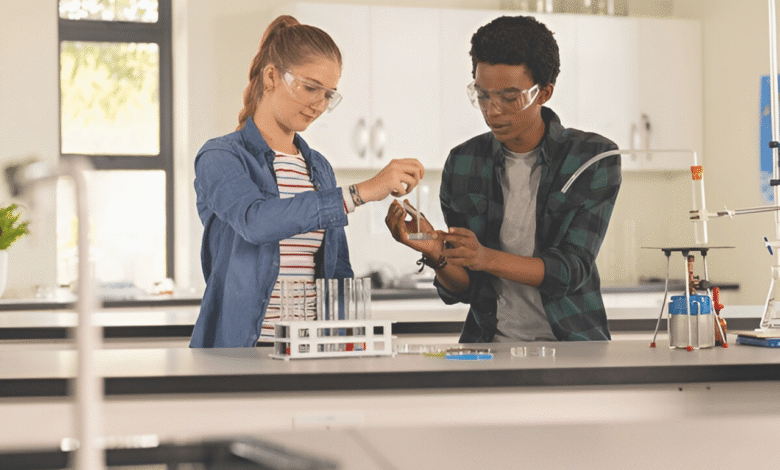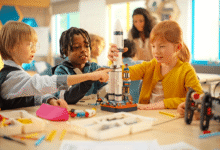Best STEM Project for Kids to Build Critical Thinking
STEM Project for kids boost critical thinking Discover 10 hands-on science & engineering activities to spark creativity & problem-solving skills.

STEM projects for kids are an excellent way to nurture critical thinking and problem-solving skills from an early age. In a world driven by innovation, exposing children to Science, Technology, Engineering, and Mathematics (STEM) through hands-on activities helps them develop logical reasoning, creativity, and analytical abilities. These projects make learning interactive and fun while preparing kids for future challenges in academics and real-life situations.
From constructing simple machines to coding basic programs, STEM projects for kids encourage experimentation and curiosity. Whether at home or in the classroom, these activities foster independent thinking and teamwork, helping children understand complex concepts in an engaging way. By integrating play with education, parents and educators can inspire the next generation of innovators and problem-solvers.
Best STEM Projects for Kids to Build Critical Thinking
Building a Straw Bridge
One of the most engaging STEM projects for kids is constructing a straw bridge. This Critical Thinking teaches children about engineering principles, weight distribution, and structural stability. Kids use straws, tape, and glue to design a bridge that can hold a specific weight. Through trial and error, they learn how different shapes (like triangles or arches) affect strength. This project enhances problem-solving skills as they refine their designs to improve durability. It also introduces basic physics concepts, making it a perfect blend of learning and creativity.
Creating a Homemade Volcano
A classic yet effective STEM Projects, the homemade volcano demonstrates chemical reactions in an exciting way. Using baking soda, vinegar, and food coloring, kids simulate a volcanic eruption while learning about acids and bases. This experiment encourages scientific inquiry as children predict outcomes and observe reactions. They can modify ingredient quantities to see how it affects the eruption, fostering analytical thinking. Additionally, decorating the volcano enhances artistic skills, making it a multidisciplinary activity.
Designing a Solar Oven
Teaching kids about renewable energy and heat transfer, a solar oven project is both educational and Critical Thinking. Using a pizza box, aluminum foil, and plastic wrap, children build a simple oven that cooks food using sunlight. This project introduces concepts like solar energy, insulation, and the greenhouse effect. Kids experiment with angles and materials to maximize efficiency, improving their critical thinking and innovation skills. It’s a great way to discuss sustainability while engaging in a fun, hands-on activity.
Constructing a Balloon-Powered Car
The balloon-powered car project combines physics and engineering, teaching kids about motion, force, and aerodynamics. Using a Plastic bottle, straws, and a balloon, they build a car that moves using air propulsion. Children test different designs to see which travels Critical Thinking, learning about thrust and friction. This project enhances problem-solving abilities as they adjust wheel alignment and balloon size for optimal performance. It’s an exciting way to explore Newton’s Third Law of Motion in a tangible way.
Coding a Simple Game with Scratch
Introducing kids to coding through Scratch, a beginner-friendly platform, helps develop logical Critical Thinking and creativity. They can design simple games or Critical Thinking by dragging and dropping code blocks. This project teaches computational thinking, sequencing, and debugging. As kids experiment with different commands, they learn cause-and-effect relationships in programming. It’s a fantastic way to prepare them for future technology-driven careers while boosting their confidence in problem-solving.
Growing Crystals at Home
Hands-On Learning of Chemical Processes
This chemistry-based STEM project lets kids explore saturation and molecular structures by growing crystals from common household materials like salt, sugar, or borax. As they dissolve these substances in water and observe the gradual formation of crystals over days, they learn how supersaturated solutions lead to crystal growth. By experimenting with different concentrations and temperatures, children discover how these factors influence crystal size, shape, and formation speed turning abstract chemistry concepts into tangible, visually striking results.
Development of Scientific Skills
Beyond just creating pretty crystals, this project strengthens observation, patience, and scientific reasoning. Kids practice the scientific method by forming Critical Thinking (e.g., “Will hotter water grow bigger crystals?”) and testing variables. Tracking daily changes sharpens their attention to detail, while the delayed gratification of crystal growth teaches perseverance. The activity also sparks curiosity about real-world applications, from geology (how minerals form) to industrial chemistry (synthetic crystal production), making it a perfect blend of education and wonder.
Building a Simple Circuit with LEDs
Teaching basic Critical Thinking, this project involves creating a circuit using a battery, wires, and an LED light. Kids learn about conductivity, closed circuits, and energy flow. By experimenting with different components, they understand how electricity works. This activity enhances critical thinking as they troubleshoot connections to make the light glow. It’s a foundational skill for future engineering projects and robotics.
Designing a Water Filtration System
A water filtration project introduces kids to environmental science and engineering. Using sand, gravel, and activated charcoal, they build a filter to clean dirty Critical Thinking. This experiment teaches the importance of clean water and how filtration works. Kids test different materials to see which combination purifies water best, improving their analytical skills. It’s a meaningful project that combines science with real-world applications.
Creating a Marshmallow Catapult
The marshmallow catapult is an exciting physics-based STEM project that brings fundamental concepts like force, trajectory, and energy transfer to life. Using simple materials like popsicle sticks, rubber bands, and a plastic spoon, kids construct their own miniature Critical Thinking, then experiment by launching marshmallows across the room. As they adjust the launch angle and rubber band tension, they observe firsthand how these variables affect distance and accuracy applying mathematical principles like projectile motion and measuring results.
Exploring Density with a Liquid Layering Experiment
This chemistry project provides a visually striking way for kids to explore density through liquid layering. By carefully pouring substances like honey, dish soap, water, oil, and rubbing alcohol into a clear container, children can observe how these liquids naturally separate into distinct layers based on their molecular weight and buoyancy. The experiment demonstrates why denser liquids (like honey) sink while less dense ones (like oil) float, making abstract scientific principles tangible and Critical Thinking. As kids predict and test different liquid combinations, they develop scientific curiosity and hypothesis-testing skills.
Read More: Master New Skills with These Fast-Growing Online Learning Sites
Conclusion
STEM projects for kids offer one of the most effective ways to develop critical thinking while making learning exciting and hands-on. By engaging in these activities, children not only grasp fundamental scientific and mathematical concepts but also learn how to approach problems methodically. Whether building bridges, coding simple games, or conducting chemistry experiments, each project strengthens their ability to analyze, innovate, and think outside the box skills that will benefit them throughout their lives.
As parents and educators, introducing STEM projects for kids early on can spark a lifelong passion for discovery and problem-solving. These activities go beyond textbooks, teaching children how to collaborate, experiment, and persevere through challenges. By fostering creativity and logical reasoning, we equip young minds with the tools they need to thrive in an increasingly technology-driven world, ensuring they grow into confident, capable thinkers ready to tackle future innovations.
FAQs
What are the best STEM projects for beginners?
Simple projects like homemade volcanoes, straw bridges, and balloon-powered cars are great for beginners.
How do STEM projects improve critical thinking?
They encourage problem-solving, experimentation, and logical reasoning through hands-on learning.
Are STEM projects suitable for all age groups?
Yes, projects can be adapted based on complexity, making them ideal for elementary to high school students.
What materials are needed for these projects?
Common household items like straws, balloons, baking soda, and batteries are often used.
Can STEM projects be done at home?
Absolutely! Many STEM activities require minimal supplies and can be conducted safely at home.











